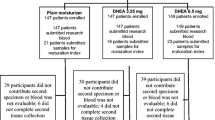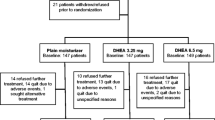Abstract
Background
Anti-estrogen therapy is an effective intervention for preventing reoccurrence of hormone receptor-positive breast cancer in women. However, the side effects of anti-estrogen therapy, including urogenital symptoms, have been reported to cause significant morbidity. There is controversial data, mainly due to small sample sizes, reporting on the safety and efficacy of using vaginal estrogen to treat urogenital symptoms in patients on aromatase inhibitor therapy.
Methods
We proposed a prospective trial to measure the change in blood estradiol levels in postmenopausal women with hormone receptor-positive breast cancer undergoing treatment with aromatase inhibitors when treated with vaginal estrogen preparation, Estring, for their urogenital symptoms. Only 8 prospective patients were enrolled, and the study was amended to include 6 retrospective patients who were treated similarly. Blood estradiol levels were measured at baseline and at week 16 for all patients.
Results
The median age for all patients was 55 years, and the majority of them were treated with anastrozole. There was no significant difference between baseline and week 16 estradiol levels (p = 0.81). In addition, patients in the prospective group reported subjective improvement in their vaginal dryness symptoms questionnaires.
Conclusions
The vaginal estrogen preparation, Estring, did not cause persistent elevations in serum estradiol levels and might be a safer option for women with significant urogenital symptoms requiring estrogen therapy.
Implications for cancer survivors
Vaginal estrogen preparation, Estring, might be an option for women with hormone receptor positive breast cancer who have persistent urogenital symptoms.
Similar content being viewed by others
Data availability
Corresponding author (Pavani Chalasani) has full control of all primary data and agrees to allow the journal to review their data if requested.
References
Siegel R, Miller KD, Jemal A (2017) Cancer statistics, 2017. CA Cancer J Clin 67:7–30
Derzko C, Elliott S, Lam W (2007) Management of sexual dysfunction in postmenopausal breast cancer patients taking adjuvant aromatase inhibitor therapy. Curr Oncol 14(Suppl 1):S20–S40
Smith IE, Dowsett M (2003) Aromatase inhibitors in breast cancer. N Engl J Med 348:2431–2442
Baumgart J, Nilsson K, Evers AS, Kallak TK, Poromaa IS (2013) Sexual dysfunction in women on adjuvant endocrine therapy after breast cancer. Menopause. 20:162–168
Runowicz CD, Leach CR, Henry NL, Enry KS, Mackey HT et al (2016) American Cancer Society/American Society of Clinical Oncology Breast Cancer Survivorship Care guideline. J Clin Oncol 34:611–635
(2013) Management of symptomatic vulvovaginal atrophy: 2013 position statement of the North American Menopause Society. Menopause 20:888–902
Goetsch MF, Lim JY, Caughey AB (2015) A practical solution for dyspareunia in breast cancer survivors: a randomized controlled trial. J Clin Oncol 33:3394–3400
Goetsch MF, Lim JY, Caughey AB (2014) Locating pain in breast cancer survivors experiencing dyspareunia: a randomized controlled trial. Obstet Gynecol 123:1231–1236
Sulaica E, Han T, Wang W, Bhat R, Trivedi MV, Niravath P (2016) Vaginal estrogen products in hormone receptor-positive breast cancer patients on aromatase inhibitor therapy. Breast Cancer Res Treat 157:203–210
Farrell R (2016) ACOG Committee opinion number 659
Kendall A, Dowsett M, Folkerd E, Smith I (2006) Caution: vaginal estradiol appears to be contraindicated in postmenopausal women on adjuvant aromatase inhibitors. Ann Oncol 17:584–587
Pfeiler G, Glatz C, Königsberg R, Geisendorfer T, Fink-Retter A, Kubista E, Singer CF, Seifert M (2011) Vaginal estriol to overcome side-effects of aromatase inhibitors in breast cancer patients. Climacteric. 14:339–344
Wills S, Ravipati A, Venuturumilli P, Kresge C, Folkerd E, Dowsett M, Hayes DF, Decker DA (2012) Effects of vaginal estrogens on serum estradiol levels in postmenopausal breast cancer survivors and women at risk of breast cancer taking an aromatase inhibitor or a selective estrogen receptor modulator. J Oncol Pract 8:144–148
Donders G, Neven P, Moegele M, Lintermans A, Bellen G, Prasauskas V, Grob P, Ortmann O, Buchholz S (2014) Ultra-low-dose estriol and Lactobacillus acidophilus vaginal tablets (Gynoflor®) for vaginal atrophy in postmenopausal breast cancer patients on aromatase inhibitors: pharmacokinetic, safety, and efficacy phase in clinical study. Breast Cancer Res Treat 145:371–379
Melisko ME, Goldman ME, Hwang J, De Luca A, Fang S et al (2017) Vaginal testosterone cream vs estradiol vaginal ring for vaginal dryness or decreased libido in women receiving aromatase inhibitor for early-stage breast cancer: a randomized clinical trial. JAMA Oncol 3(3):313–319
Faupel-Badger JM, Fuhrman BJ, Xu X, Falk RT (2010) Comparison of liquid chromatography-tandem mass spectrometry, RIA, and ELISA methods for measurement of urinary estrogens. Cancer Epidemiol Biomark Prev 19:292–300
Acknowledgments
We would like to acknowledge Dr. Robert Livingston for his assistance in the design and initiation of this clinical trial.
Funding
Funding for this clinical trial was provided by the University of Arizona Cancer Center Support Grant # P30 CA 023074–34.
Author information
Authors and Affiliations
Corresponding author
Ethics declarations
Conflict of interest
Dr. Alyssa Streff and Michelle Chu-Pilli report no conflict of interest.
Dr. Alison Stopeck reports grants and personal fees from Amgen, personal fees from Novartis, personal fees from Biothera, personal fees from Pfizer, personal fees from AstraZeneca, grants from Seattle Genetics. None of these funding sources are involved/overlap with the current submitted trial.
Dr. Pavani Chalasani reports research funding from Pzifer, advisory boards for Nanostring, Heron therapeutics, Astrazeneca, Amgen, Bayer, Novartis. None of these funding sources are involved/overlap with the current submitted trial.
Additional information
Publisher’s note
Springer Nature remains neutral with regard to jurisdictional claims in published maps and institutional affiliations.
Rights and permissions
About this article
Cite this article
Streff, A., Chu-Pilli, M., Stopeck, A. et al. Changes in serum estradiol levels with Estring in postmenopausal women with breast cancer treated with aromatase inhibitors. Support Care Cancer 29, 187–191 (2021). https://doi.org/10.1007/s00520-020-05466-1
Received:
Accepted:
Published:
Issue Date:
DOI: https://doi.org/10.1007/s00520-020-05466-1




